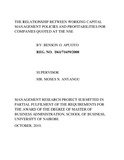| dc.description.abstract | Working capital management (WMC) is of particular importance to listed companies at Nairobi Stock Exchange (NSE). With limited access to long - term capital markets, these firms tend to rely more heavily on equity financing, trade credit and short term bank loans to finance their needed investment in cash; accounts receivable and inventory. However the impact of the working capital management policies on a firm's profitability has varying views among financial managers. The objective of this research study was to establish whether there is a relationship between working capital management policies and profitability of companies quoted at NSE.
The population of interest for the study was all public companies listed at the NSE. These companies were fifty five as at 31 st December, 2009. Proportionate random stratified sampling was used. The classification of the companies was based on sector categorization as done by the NSE. Secondary data for the research was extracted from the audited financial statements of the companies sampled. For each firm sampled, annual data on the assets, liabilities, total shareholders' equity and the profit before tax were collected for a period of five years from 2005 up to 2009.
The data collected was analyzed to determine the individual company's annual working capital policy as measured by the long - term financing of current assets and also the profitability of. the company. The annual working capital management policy and profitability were averaged using the simple arithmetic mean to get the five year average for each of the company in the sample. The companies were then grouped into three categories of aggressive, moderate and 'conservative depending on their working capital management policy.The statistical significance of the differences between the three working management policies was done using the student'!' statistic. Multiple regression analysis was done to establish the relationship between the working capital management policy and the return on total assets which was used as a measure of profitability.
The results of the analysis showed that the firms: profitability. as measured by ROTA increases with firm's size' gross working capital efficiency and with a lesser aggressiveness of the asset management. thus contrary to the traditional theory of asset management, where a conservative policy is expected to sacrifice profitability at the expense of liquidity the research study found out that there is a positive relationship between a conservative working capital management policy and the prifitability of the companies quoted at the NSE. The findings of the research also showed that there are significant differences between the working capital management policies across the five sectors. | en_US |

